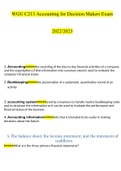Samenvatting
Summary and case notes of HPI4002 Innovation and Quality management, master HPIM
- Instelling
- Maastricht University (UM)
Summary and case notes of HPI4002 Innovation and Quality management. Extensive information on every case can be found in the case notes, an overview for studying is displayed in the summary.
[Meer zien]













